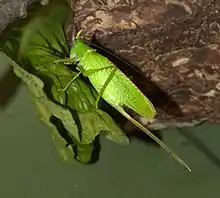Copiphora rhinoceros
Copiphora rhinoceros, the rhinoceros katydid, is a relatively large, up to about 7.5 cm (3 in) long, species of katydid found in Central America.[1] It belongs to a group known as the conehead katydids, several of which have a horn-like projection on the top of the head. The horn of the rhinoceros katydid is used to ward off attacks from hungry bats.[2] Unlike most katydids, which are herbivores, the rhinoceros katydid is an omnivore, feeding on fruit, seeds, flowers, invertebrates, frog eggs and small lizards.[2][3] The species can be quite noisy during the night and produces one of the dominant sounds in Central American lowland forests.[3] Its lifespan is one to two years.[2]
| Copiphora rhinoceros | |
|---|---|
_(6941262892).jpg.webp) | |
 | |
| Male above, females below (note prominent ovipositor) | |
| Scientific classification | |
| Domain: | Eukaryota |
| Kingdom: | Animalia |
| Phylum: | Arthropoda |
| Class: | Insecta |
| Order: | Orthoptera |
| Suborder: | Ensifera |
| Family: | Tettigoniidae |
| Genus: | Copiphora |
| Species: | C. rhinoceros |
| Binomial name | |
| Copiphora rhinoceros Pictet, 1888 | |
It was first described in 1888 by Alphonse Pictet in his Locustides Nouveaux ou peu connus de Musée de Genève (New or Little-known Locusts of the Geneva Museum).[4]
References
- Cigliano, M. M.; Braun, H.; Eades, D. C.; Otte, D. "species Copiphora rhinoceros Pictet, 1888". orthoptera.speciesfile.org. Orthoptera Species File. Retrieved 28 December 2018.
- "Cincinnati Zoo Invertebrates". Retrieved 2017-02-19.
- Hanson, P.E.; Nishida, K. (2016). Insects and other arthropods of Tropical America. Comstock Publishing Associates. pp. 29, 31. ISBN 978-0801456947.
- Pictet, A. (1888). "Locustides Nouveaux ou peu connus de Musée de Genève". Mémoires de la Société de physique et d'histoire naturelle de Genève. 30 (6). Retrieved 28 December 2018.